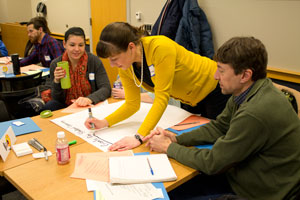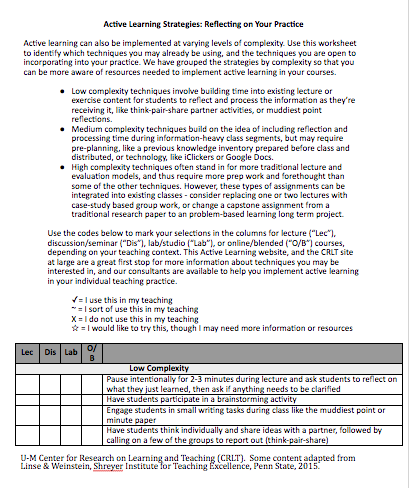Reflecting on Your Practice

Active learning can also be implemented at varying levels of complexity. Use this worksheet to identify which techniques you may already be using, and the techniques you are open to incorporating into your practice. We have grouped the strategies by complexity so that you can be more aware of resources needed to implement active learning in your courses.
- Low complexity techniques involve building time into existing lecture or exercise content for students to reflect and process the information as they’re receiving it, like think-pair-share partner activities or "muddiest point" reflections.
- Medium complexity techniques build on the idea of including reflection and processing time during information-heavy class segments, but may require pre-planning. For example, a previous knowledge inventory prepared before class and distributed or the use of technology, like iClickers or Google Docs.
- High complexity techniques often stand in for more traditional lecture and evaluation models, and thus require more prep work and forethought than some of the other techniques. However, these types of assignments can be integrated into existing classes. For example, consider replacing one or two lectures with case study-based group work or change a capstone assignment from a traditional research paper to an problem-based learning, long-term project.
Use the codes below to mark your selections in the columns for lecture (“Lec”), discussion/seminar (“Dis”), lab/studio (“Lab”), or online/blended (“O/B”) courses, depending on your teaching context. You can enter them in the webform (your responses are not sent to CRLT) or download and print the PDF version. This active learning website, and the CRLT site at large, are a great first stop for more information about techniques you may be interested in. Our consultants are available to help you implement active learning in your individual teaching practice.
Y = I use this in my teaching
~ = I sort of use this in my teaching
N = I do not use this in my teaching
* = I would like to try this, though I may need more information or resources
| Lec | Dis | Lab | O/B | |
|
Low Complexity |
||||
| Pause intentionally for 2-3 minutes during lecture and ask students to reflect on what they just learned, then ask if anything needs to be clarified | ||||
| Have students participate in a brainstorming activity | ||||
| Engage students in small writing tasks during class like the muddiest point or minute paper | ||||
| Have students think individually and share ideas with a partner, followed by calling on a few of the groups to report out (think-pair-share) | ||||
| Have students engage in in-class reading activities that are followed by a class discussion | ||||
| Have students watch a short video or several video clips and discuss themes or issues in small or large groups | ||||
| Lec | Dis | Lab | O/B | |
|
Medium Complexity |
||||
| Have students write one idea on a post-it note about a question, then have the class sort the questions into categories, and discuss the categories | ||||
| Have students peer-review a paper or assignment and give each other feedback | ||||
| Engage students in a fishbowl activity (i.e. some students sitting in a circle ask questions, present opinions, and share information, while other students outside the circle listen carefully to the ideas presented and pay attention to the process. The reverse the roles.) | ||||
| Have students do paired annotations (e.g. students pair up to review/learn one article, chapter, or content area and exchange double-entry journals for reading and reflection.) | ||||
| Engage students in active review (e.g. discuss and review material or potential solutions to problems) | ||||
| Engage students in guided, reciprocal, peer questioning activity (e.g. generate discussion among student groups about a specific topic or content area) | ||||
| Have students take a short, ungraded quiz to check student comprehension of the material | ||||
| Engage students in self-reflection individually or in small groups (e.g. use a self-assessment inventory) | ||||
| Have students work in pairs, triads, or small groups on class assignments | ||||
| Have students answer questions by using iClickers, or other technology tools, to check student understanding | ||||
| Lec | Dis | Lab | O/B | |
|
High Complexity |
||||
| Have students in small groups work cooperatively on a task (e.g. do a jigsaw activity) | ||||
| Engage students in inquiry-based learning (i.e. distribute pertinent information and give students the flexibility to formulate their own problem, instead of merely asking students to replicate) | ||||
| Engage students in case-based learning (e.g. ask students to read and discuss complex, real-life scenarios that call on their analytical and decision-making skills) | ||||
| Engage students in problem-based learning (e.g. frame the problem as a long-term investigation permitting students to develop and enhance investigative, procedural, and communicative skills). | ||||
| Have students engage in role-play exercises or simulations | ||||
| Engage students in real-world problems or situations (e.g. identify issues/problems on or off campus, proposing possible solutions. Then work with the community to improve the situations or solve the problems) | ||||
| Engage students in reflective dialogue and activities using forum theatre and similar methods | ||||

